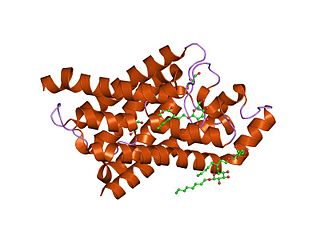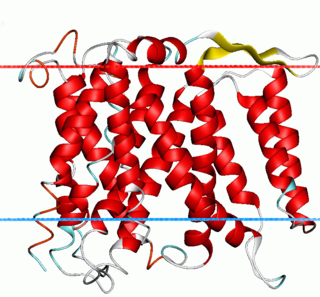Related Research Articles
Magnesium transporters are proteins that transport magnesium across the cell membrane. All forms of life require magnesium, yet the molecular mechanisms of Mg2+ uptake from the environment and the distribution of this vital element within the organism are only slowly being elucidated.

Major intrinsic proteins comprise a large superfamily of transmembrane protein channels that are grouped together on the basis of homology. The MIP superfamily includes three subfamilies: aquaporins, aquaglyceroporins and S-aquaporins.
- The aquaporins (AQPs) are water selective.
- The aquaglyceroporins are permeable to water, but also to other small uncharged molecules such as glycerol.
- The third subfamily, with little conserved amino acid sequences around the NPA boxes, include 'superaquaporins' (S-aquaporins).
In enzymology, a polyphosphate kinase, or polyphosphate polymerase, is an enzyme that catalyzes the formation of polyphosphate from ATP, with chain lengths of up to a thousand or more orthophosphate moieties.
The Nucleobase:Cation Symporter-1 (NCS1) Family (TC# 2.A.39) consists of over 1000 currently sequenced proteins derived from Gram-negative and Gram-positive bacteria, archaea, fungi and plants. These proteins function as transporters for nucleobases including purines and pyrimidines. Members of this family possess twelve transmembrane α-helical spanners (TMSs). At least some of them have been shown to function in uptake by substrate:H+ symport mechanism.
Cation diffusion facilitators (CDFs) are transmembrane proteins that provide tolerance of cells to divalent metal ions, such as cadmium, zinc, and cobalt. These proteins are considered to be efflux pumps that remove these divalent metal ions from cells. However, some members of the CDF superfamily are implicated in ion uptake. All members of the CDF family possess six putative transmembrane spanners with strongest conservation in the four N-terminal spanners. The Cation Diffusion Facilitator (CDF) Superfamily includes the following families:

The mercury transporter superfamily is a family of transmembrane bacterial transporters of mercury ions. The common origin of all Mer superfamily members has been established. The common elements between family members are included in TMSs 1-2. A representative list of the subfamilies and proteins that belong to those subfamilies is available in the Transporter Classification Database.
The amino acid-polyamine-organocation (APC) superfamily is the second largest superfamily of secondary carrier proteins currently known, and it contains several Solute carriers. Originally, the APC superfamily consisted of subfamilies under the transporter classification number. This superfamily has since been expanded to include eighteen different families.
The Hydroxy/Aromatic Amino Acid Permease (HAAAP) Family is a member of the large Amino Acid-Polyamine-OrganoCation (APC) Superfamily of secondary carrier proteins. Members of the HAAAP family all function in amino acid uptake. Homologues are present in a large number of Gram-negative and Gram-positive bacteria, with at least one member classified from archaea .
The anion exchanger family is a member of the large APC superfamily of secondary carriers. Members of the AE family are generally responsible for the transport of anions across cellular barriers, although their functions may vary. All of them exchange bicarbonate. Characterized protein members of the AE family are found in plants, animals, insects and yeast. Uncharacterized AE homologues may be present in bacteria. Animal AE proteins consist of homodimeric complexes of integral membrane proteins that vary in size from about 900 amino acyl residues to about 1250 residues. Their N-terminal hydrophilic domains may interact with cytoskeletal proteins and therefore play a cell structural role. Some of the currently characterized members of the AE family can be found in the Transporter Classification Database.
The sulfate permease (SulP) family is a member of the large APC superfamily of secondary carriers. The SulP family is a large and ubiquitous family of proteins derived from archaea, bacteria, fungi, plants and animals. Many organisms including Bacillus subtilis, Synechocystis sp, Saccharomyces cerevisiae, Arabidopsis thaliana and Caenorhabditis elegans possess multiple SulP family paralogues. Many of these proteins are functionally characterized, and most are inorganic anion uptake transporters or anion:anion exchange transporters. Some transport their substrate(s) with high affinities, while others transport it or them with relatively low affinities. Others may catalyze SO2−
4:HCO−
3 exchange, or more generally, anion:anion antiport. For example, the mouse homologue, SLC26A6, can transport sulfate, formate, oxalate, chloride and bicarbonate, exchanging any one of these anions for another. A cyanobacterial homologue can transport nitrate. Some members can function as channels. SLC26A3 and SLC26A6 can function as carriers or channels, depending on the transported anion. In these porters, mutating a glutamate, also involved in transport in the CIC family, created a channel out of the carrier. It also changed the stoichiometry from 2Cl−/HCO−
3 to 1Cl−/HCO−
3.

Natural resistance-associated macrophage proteins (Nramps), also known as metal ion (Mn2+-iron) transporters (TC# 2.A.55), are a family of metal transport proteins found throughout all domains of life. Taking on an eleven-helix LeuT fold, the Nramp family is a member of the large APC Superfamily of secondary carriers. They transport a variety of transition metals such as manganese, cadmium, and manganese using an alternating access mechanism characteristic of secondary transporters.
The potassium (K+) uptake permease (KUP) family (TC# 2.A.72) is a member of the APC superfamily of secondary carriers. Proteins of the KUP/HAK/KT family include the KUP (TrkD) protein of E. coli and homologues in both Gram-positive and Gram-negative bacteria. High affinity (20 μM) K+ uptake systems (Hak1, TC# 2.A.72.2.1) of the yeast Debaryomyces occidentalis as well as the fungus, Neurospora crassa, and several homologues in plants have been characterized. Arabidopsis thaliana and other plants possess multiple KUP family paralogues. While many plant proteins cluster tightly together, the Hak1 proteins from yeast as well as the two Gram-positive and Gram-negative bacterial proteins are distantly related on the phylogenetic tree for the KUP family. All currently classified members of the KUP family can be found in the Transporter Classification Database.
The Ca2+:cation antiporter (CaCA) family (TC# 2.A.19) is a member of the cation diffusion facilitator (CDF) superfamily. This family should not be confused with the Ca2+:H+ Antiporter-2 (CaCA2) Family (TC# 2.A.106) which belongs to the Lysine Exporter (LysE) Superfamily. Proteins of the CaCA family are found ubiquitously, having been identified in animals, plants, yeast, archaea and divergent bacteria. Members of this family facilitate the antiport of calcium ion with another cation.
The multidrug/oligosaccharidyl-lipid/polysaccharide (MOP) flippase superfamily is a group of integral membrane protein families. The MOP flippase superfamily includes twelve distantly related families, six for which functional data are available:
- One ubiquitous family (MATE) specific for drugs - (TC# 2.A.66.1) The Multi Antimicrobial Extrusion (MATE) Family
- One (PST) specific for polysaccharides and/or their lipid-linked precursors in prokaryotes - (TC# 2.A.66.2) The Polysaccharide Transport (PST) Family
- One (OLF) specific for lipid-linked oligosaccharide precursors of glycoproteins in eukaryotes - (TC# 2.A.66.3) The Oligosaccharidyl-lipid Flippase (OLF) Family
- One (MVF) lipid-peptidoglycan precursor flippase involved in cell wall biosynthesis - (TC# 2.A.66.4) The Mouse Virulence Factor (MVF) Family
- One (AgnG) which includes a single functionally characterized member that extrudes the antibiotic, Agrocin 84 - (TC# 2.A.66.5) The Agrocin 84 Antibiotic Exporter (AgnG) Family
- And finally, one (Ank) that shuttles inorganic pyrophosphate (PPi) - (TC# 2.A.66.9) The Progressive Ankylosis (Ank) Family
The iron/lead transporter (ILT) family is a family of transmembrane proteins within the lysine exporter (LysE) superfamily. The ILT family includes two subfamilies, the iron-transporting (OFeT) family and the lead-transporting (PbrT) family. A representative list of the proteins belonging to these subfamilies of the ILT family can be found in the Transporter Classification Database.
Divalent anion:Na+ symporters were found in bacteria, archaea, plant chloroplasts and animals.
The 6TMS Neutral Amino Acid Transporter (NAAT) Family is a family of transporters belonging to the Lysine Exporter (LysE) Superfamily. Homologues are found in numerous Gram-negative and Gram-positive bacteria including many human pathogens. Several archaea also encode MarC homologues. Some of these organisms have 2 or more paralogues. Most of these proteins are of about the same size although a few are larger. They exhibit 6 putative TMSs. A representative list of members belonging to the NAAT family can be found in the Transporter Classification Database.

The Monovalent Cation:Proton Antiporter-1 (CPA1) Family (TC# 2.A.36) is a large family of proteins derived from Gram-positive and Gram-negative bacteria, blue-green bacteria, archaea, yeast, plants and animals. The CPA1 family belongs to the VIC superfamily. Transporters from eukaryotes have been functionally characterized to catalyze Na+:H+ exchange. Their primary physiological functions are thought to be in (1) cytoplasmic pH regulation, extruding the H+ generated during metabolism, and (2) salt tolerance (in plants), due to Na+ uptake into vacuoles. Bacterial homologues have also been found to facilitate Na+:H+ antiport, but some also catalyze Li+:H+ antiport or Ca2+:H+ antiport under certain conditions.
The inorganic phosphate transporter (PiT) family is a group of carrier proteins derived from Gram-negative and Gram-positive bacteria, archaea, and eukaryotes.
The K+Transporter (Trk) Family is a member of the voltage-gated ion channel (VIC) superfamily. The proteins of the Trk family are derived from Gram-negative and Gram-positive bacteria, yeast and plants.
References
- ↑ Reizer J, Reizer A, Saier MH (1993-01-01). "The MIP family of integral membrane channel proteins: sequence comparisons, evolutionary relationships, reconstructed pathway of evolution, and proposed functional differentiation of the two repeated halves of the proteins". Critical Reviews in Biochemistry and Molecular Biology. 28 (3): 235–57. doi:10.3109/10409239309086796. PMID 8325040.
- ↑ Park JH, Saier MH (October 1996). "Phylogenetic characterization of the MIP family of transmembrane channel proteins". The Journal of Membrane Biology. 153 (3): 171–80. doi:10.1007/s002329900120. PMID 8849412. S2CID 1559932.
- ↑ Suppmann B, Sawers G (March 1994). "Isolation and characterization of hypophosphite--resistant mutants of Escherichia coli: identification of the FocA protein, encoded by the pfl operon, as a putative formate transporter". Molecular Microbiology. 11 (5): 965–82. doi:10.1111/j.1365-2958.1994.tb00375.x. PMID 8022272. S2CID 6425651.
- 1 2 Wang Y, Huang Y, Wang J, Cheng C, Huang W, Lu P, Xu YN, Wang P, Yan N, Shi Y (November 2009). "Structure of the formate transporter FocA reveals a pentameric aquaporin-like channel". Nature. 462 (7272): 467–72. Bibcode:2009Natur.462..467W. doi:10.1038/nature08610. PMID 19940917. S2CID 4370839.
- ↑ Saier, MH Jr. "1.A.16 The Formate-Nitrite Transporter (FNT) Family". Transporter Classification Database. Saier Lab Bioinformatics Group / SDSC.
- ↑ Falke D, Schulz K, Doberenz C, Beyer L, Lilie H, Thiemer B, Sawers RG (February 2010). "Unexpected oligomeric structure of the FocA formate channel of Escherichia coli : a paradigm for the formate-nitrite transporter family of integral membrane proteins". FEMS Microbiology Letters. 303 (1): 69–75. doi: 10.1111/j.1574-6968.2009.01862.x . PMID 20041954.
- ↑ Lü W, Du J, Wacker T, Gerbig-Smentek E, Andrade SL, Einsle O (April 2011). "pH-dependent gating in a FocA formate channel". Science. 332 (6027): 352–4. Bibcode:2011Sci...332..352L. doi:10.1126/science.1199098. PMID 21493860. S2CID 20059830.